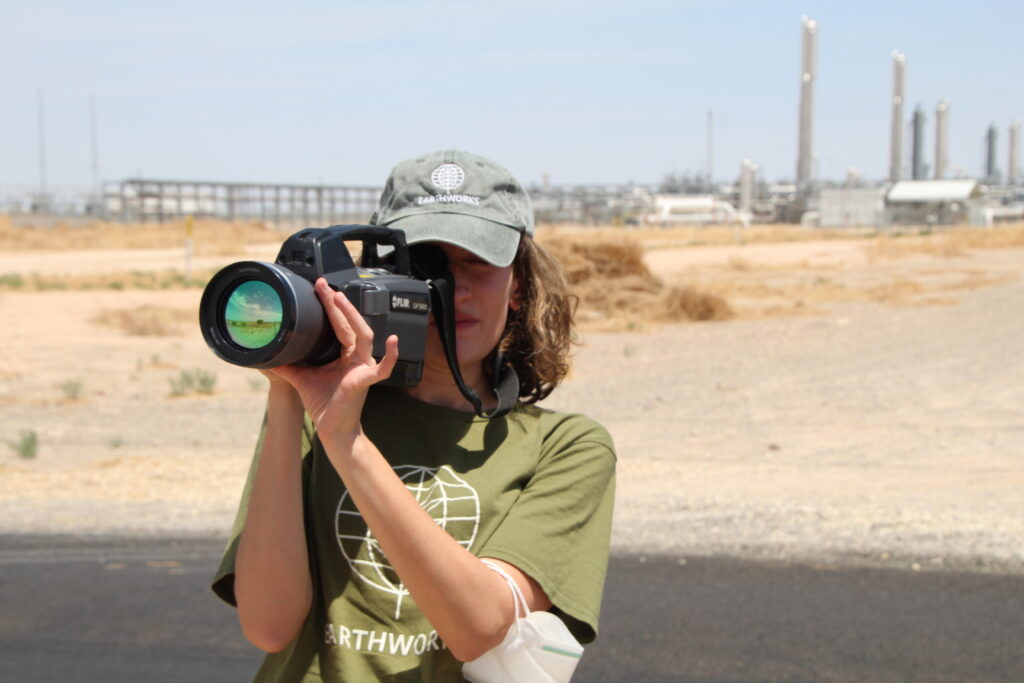Testimony delivered for public comment hearing on proposed rules to reduce oil and gas methane by the U.S. Environmental Protection Agency, 10 January, 2023.

Thank you for the opportunity to speak today. My name is Melissa Ostroff and I am a Pennsylvania Field Advocate and thermographer at Earthworks, as well as a public health professional. In this role, I use an industry-standard optical gas imaging camera to detect invisible methane and health-hazardous volatile organic compound leaks at oil and gas well sites across Pennsylvania.
What I have witnessed through my camera lens demonstrates a clear need for frequent monitoring of emissions from every oil and gas well, including those previously overlooked due to production volume or size. I am heartened to see that updates in the draft supplemental methane rule close the loophole for leak detection and repair in EPA’s prior draft methane rule by requiring routine inspections with optical gas imaging cameras at all wells with equipment known to malfunction. This is a long-awaited change that is intended to address pollution from sites like the well I visited in Boyce Park outside of Pittsburgh last summer, where a broken piece of equipment allowed enormous quantities of methane and health-hazardous pollutants to pour out of the well site continuously until I happened to take a look at it with an optical gas imaging camera.
The Super Emitter Response Program included in the draft supplemental rule is another welcome change, as it is intended to ensure that pollution events like the one I found in Boyce Park are addressed quickly even where regulatory staff is unavailable to perform their own inspections. In future drafts, the EPA must provide a clear pathway for communities and third parties like Earthworks to participate and engage in the Super Emitter Response Program.
The current draft rule requires that a pollution event meets a quantitative threshold in order to be applicable to this program. Quantification of emissions is only possible with industry data points, thus limiting participation in this program to individuals and groups working directly with oil and gas operators. This program can only be a success for frontline communities if it is made more accessible to the public, including to those without access to industry data. Additionally, the program would benefit from expansion of applicability to ongoing, smaller pollution events that impact frontline communities.
Beyond LDAR requirements and the Super Emitter Response Program, a large loophole remains for storage tanks allowing for continuous oil and gas pollution in Pennsylvania communities, and communities across the country. The public health implications are significant.
In many of my surveys of small oil and gas well sites, some of the worst pollution I see is from produced water (waste) storage tanks. These tanks are designed such that they can continuously release benzene and other health-hazardous pollutants into the air. Despite the small size of the tanks themselves, the amount of pollution generated can be enormous. And given the minimal setback requirements for conventional well pads, many of these tanks are located not only near homes and schools, but actually in literal backyards and playgrounds. Given the carcinogenic nature of these emissions, the problem must be taken seriously.
I have seen the immense clouds of pollution generated by these tanks through the lens of my camera many times. This past fall, I visited numerous well sites owned by Diversified Energy and captured footage of thick clouds of pollution pouring out of produced water tanks unabated. The current draft of the EPA methane rule would allow that pollution to continue pouring into the air of neighborhoods across the country. So I am asking EPA to close this remaining loophole for small, heavily-polluting tanks that are in close proximity to children and families by expanding the applicability threshold of the rule to these smaller storage vessels.
Finally, I must remind EPA that there is not a moment to waste in moving forward with these important regulatory changes. Every day that passes without strong national methane rules is a missed opportunity to reduce climate and air pollution from the oil and gas industry and protect the health and wellbeing of communities across this country.
We cannot continue to wait. EPA must act now to finalize its strengthened methane rule and put states like Pennsylvania on the path to cleaner air and a healthier future.
